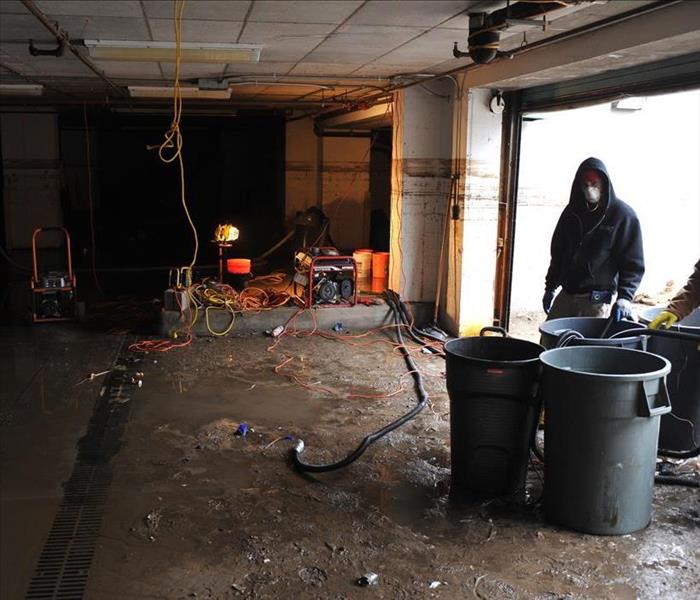A Step-by-Step Guide to Restoring Your Basement after Flooding
11/14/2020 (Permalink)
Have you experienced a flooded basement? You know the unbearable feeling that comes with this issue. Basement flooding can occur at any time, especially during springtime when snow melts and storms begin. Some other causes of basement flooding can include sump pump failure, storm sewer blockage, cracked piping or failed water heater tank. Whatever the cause of the issue, flooded basement cleanup is the solution homeowners need to undertake. Flooded basement not only feels uncomfortable, but it also increases humidity and moisture content inside your home. The moisture, in turn, encourages the growth of mold, rotting wood and becomes the breeding area for bacteria, jeopardizing the life of occupants. If you do not pump the water out promptly, then your carpets, floor, furniture and other possessions will suffer damage.
What to do?
Cleaning flooded basement is something that no person wants to experience. However, it can happen unexpectedly, so you have to remain prepared. If you experience wet floor or carpets, immediately check your basement. Chances are the water level has risen and has flooded the space. Your best solution here is to leave it for professional commercial cleaning services in Vancouver to handle.
Steps of Flood Water Removal
The process of flood basement cleanup and restoration consists of two phases: water removal and cleanup.
- Removal of Flood Water
If your basement has a small amount of water present, then you can remove the water by yourself using vacuum pumps. Dump the removed water into drains. If you do not own a water removal equipment, you can have it rented. However, it is best if you leave work for professionals. They have the resources and expertise to clear and drain the water without any hassle. They also make sure the drains remain functions by removing any clogging.
After removing water, they start to dry the area with dehumidifiers or large fans to prevent mold or mildew from growing. Remember that every basement design is different, so removal and drying methods that work for one may not work for others. Commercial cleaning services in Vancouver assess the structural design first and then employ the technique accordingly.
- Cleanup
After removal of floodwater, the next step is to commence cleanup. Carpets, upholstery and floor coverings in the basement soak water that does not dry out through traditional methods. The action requires excessive deodorizing and disinfection for cleanup. Microorganisms left behind by floodwater causes health problems and unpleasant odors. Professional cleanup services use necessary cleanup techniques to remove all surface contaminations, odors, stains and other issues.
- Final Disinfection
Experts of flood basement cleanup commence final disinfection of the area after water removal, drying and cleanup. This step is necessary to prevent mold and mildew from growing.
Tips to Prevent Basement Flooding
- Clean the gutters, drains, downspouts to keep drainage to the maximum. Divert rainwater six feet away from your home and have the ground slightly sloping away from your home
- Install a sump pump to remove the water automatically. Have the pump maintained and serviced regularly to keep it functional
- Seal the openings or cracks in basement walls, floors, foundations
- Install porous material all over the basement to absorb rainwater
- Have the drainage system checked regularly and remove any clogging
- Do not put anything down the drain or toilet that does not belong.
- Avoid using too much water during heavy rainfalls for activities like laundry or showers. It might overload the drainage or sewer system
- Install underground drain pipes to reroute the water further from your home
- Have a flood control system installed between your home and city sewer system
- Have a professional commercial cleaning service in Vancouver check the matter if you identify potential basement flooding
Safety Steps to Take If You Have Flooding
If you notice your basement has started to flood, you need to take some precautionary measures before commencing flooded basement cleanup. These include:
- Immediately cut off the electrical power supply to the area by turning off the circuit breaker. Combination of electricity and water is dangerous for anyone entering in that area, so it is best to unplug anything that further increases damage
- If the water level is low, then remove all the damp and wet material
- Try to remove the water by yourself or call in professionals
- Try to mitigate the issues that caused flooding to prevent it from happening
Potential Causes of Basement Flooding
- Heavy rainfall or snow melting
- Cracks in foundation
- Clogged or blocked sewerage system
- Improper sealing of basement walls and floors
- Failure of the sump pump
- Blockage of weeping tile
- Location of your home with inadequate sloping
- Leaks in basement piping
Final Word
Flooded basement cleanup is an activity that you need to commence immediately. If done promptly and carefully, it will save much of your belongings and protect the occupants. Call in professionals for the service for proper drying, cleanup and disinfection.





 24/7 Emergency Service
24/7 Emergency Service
